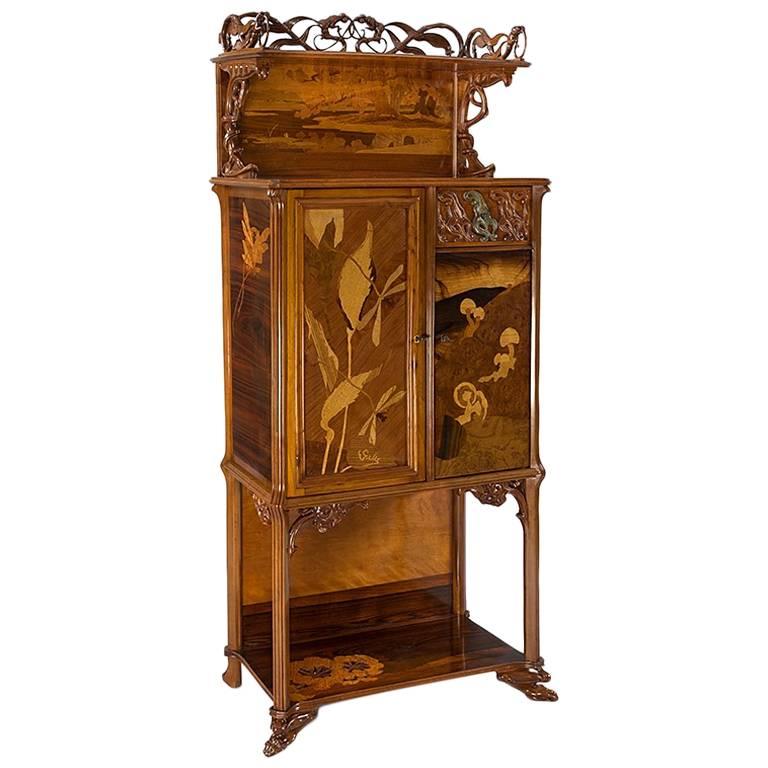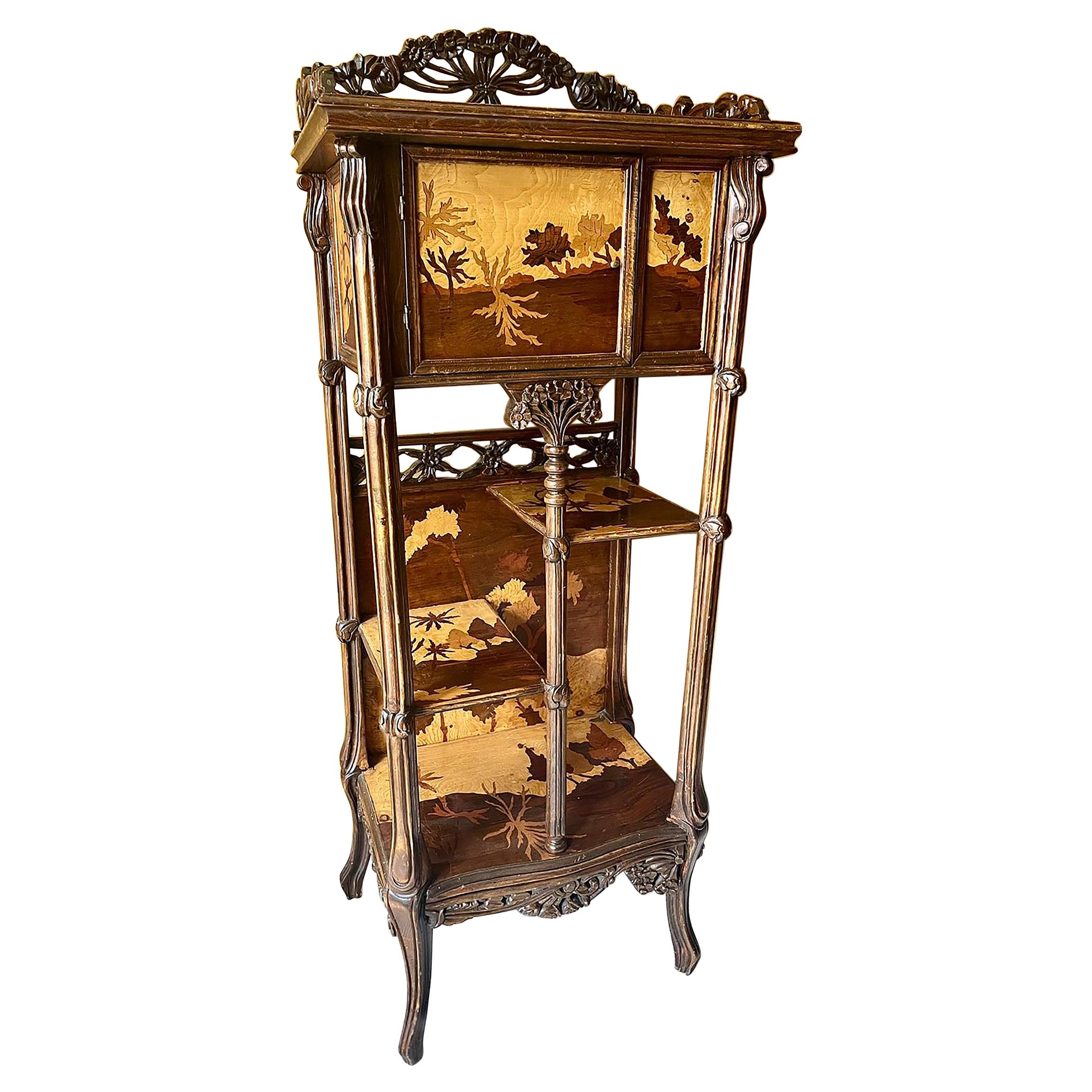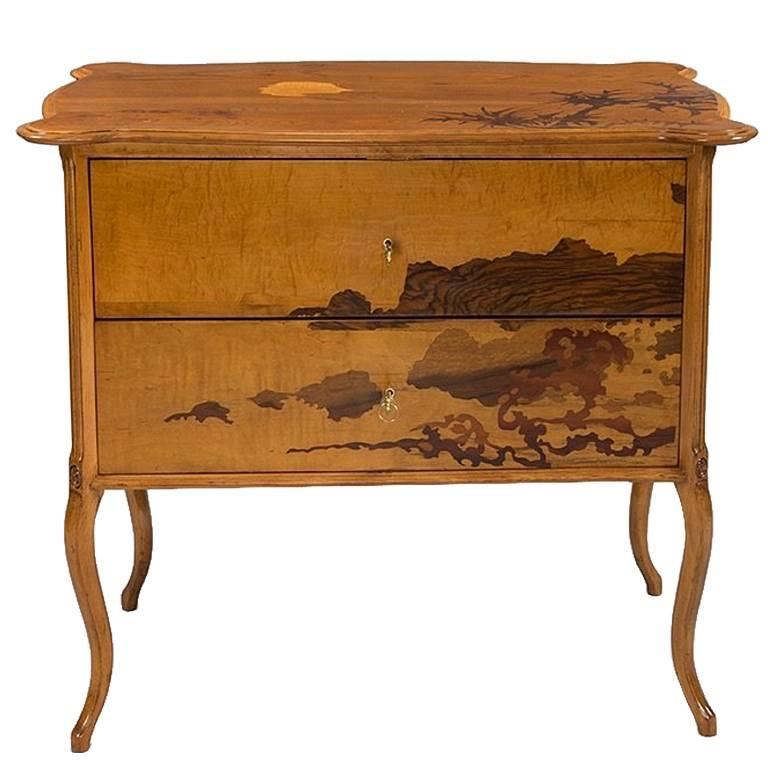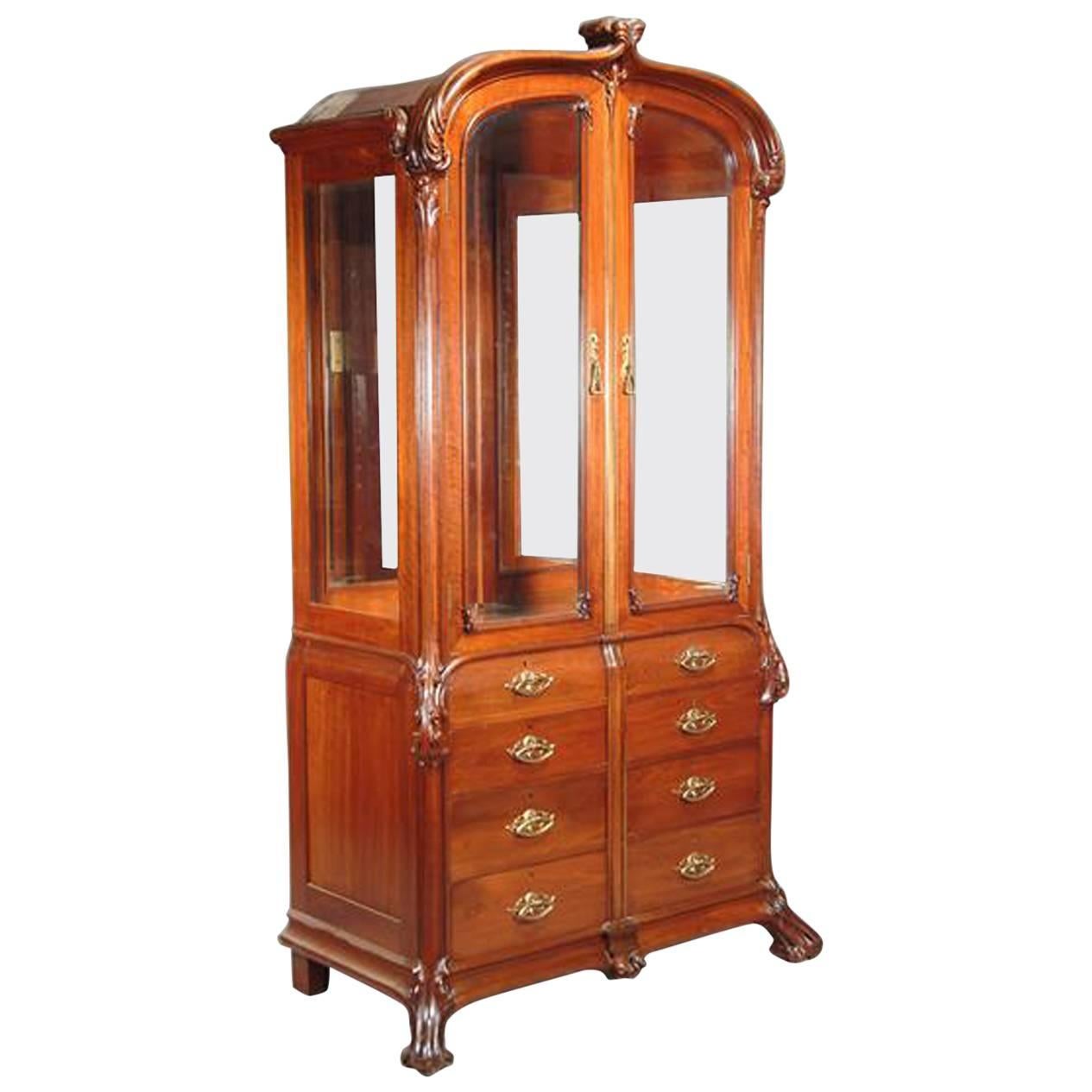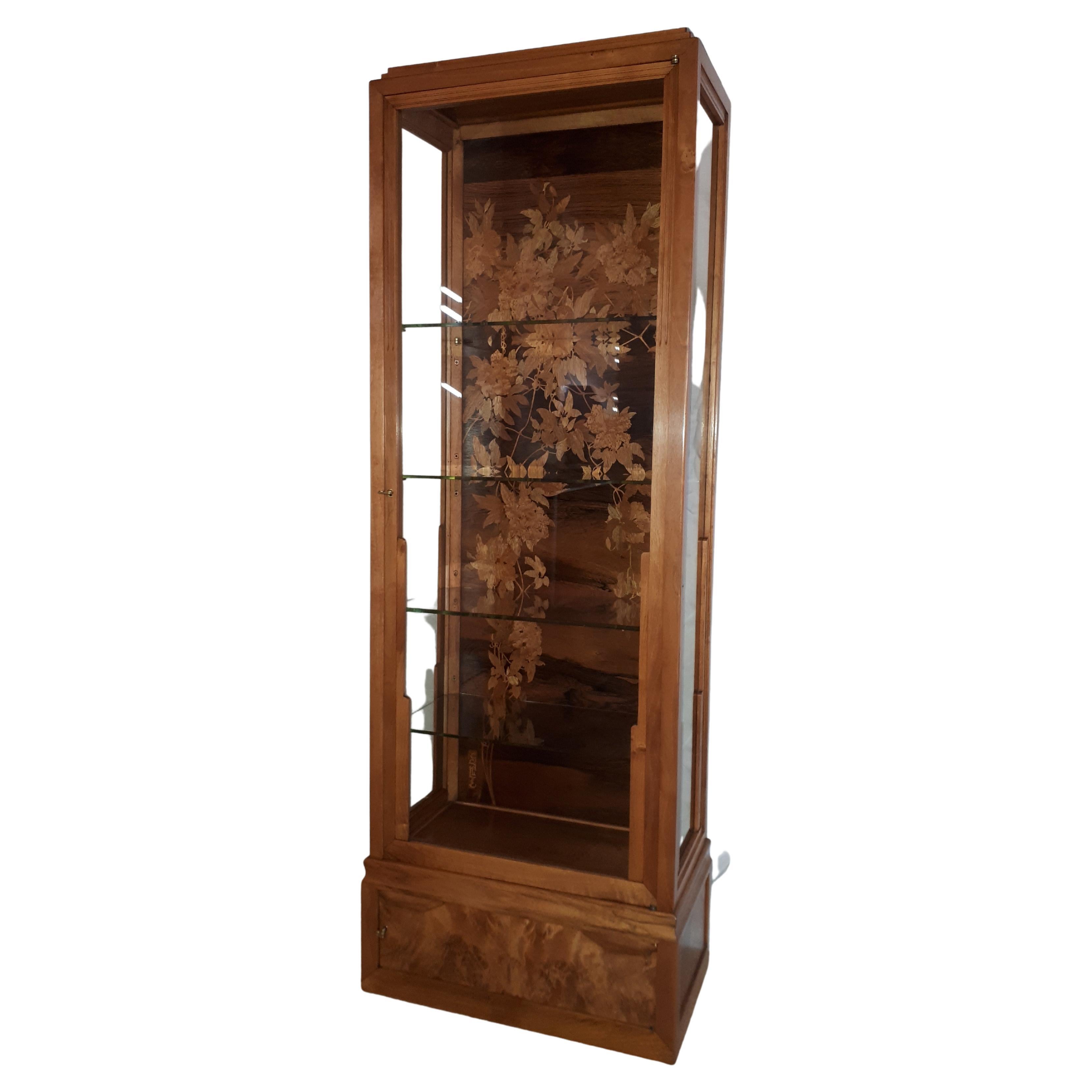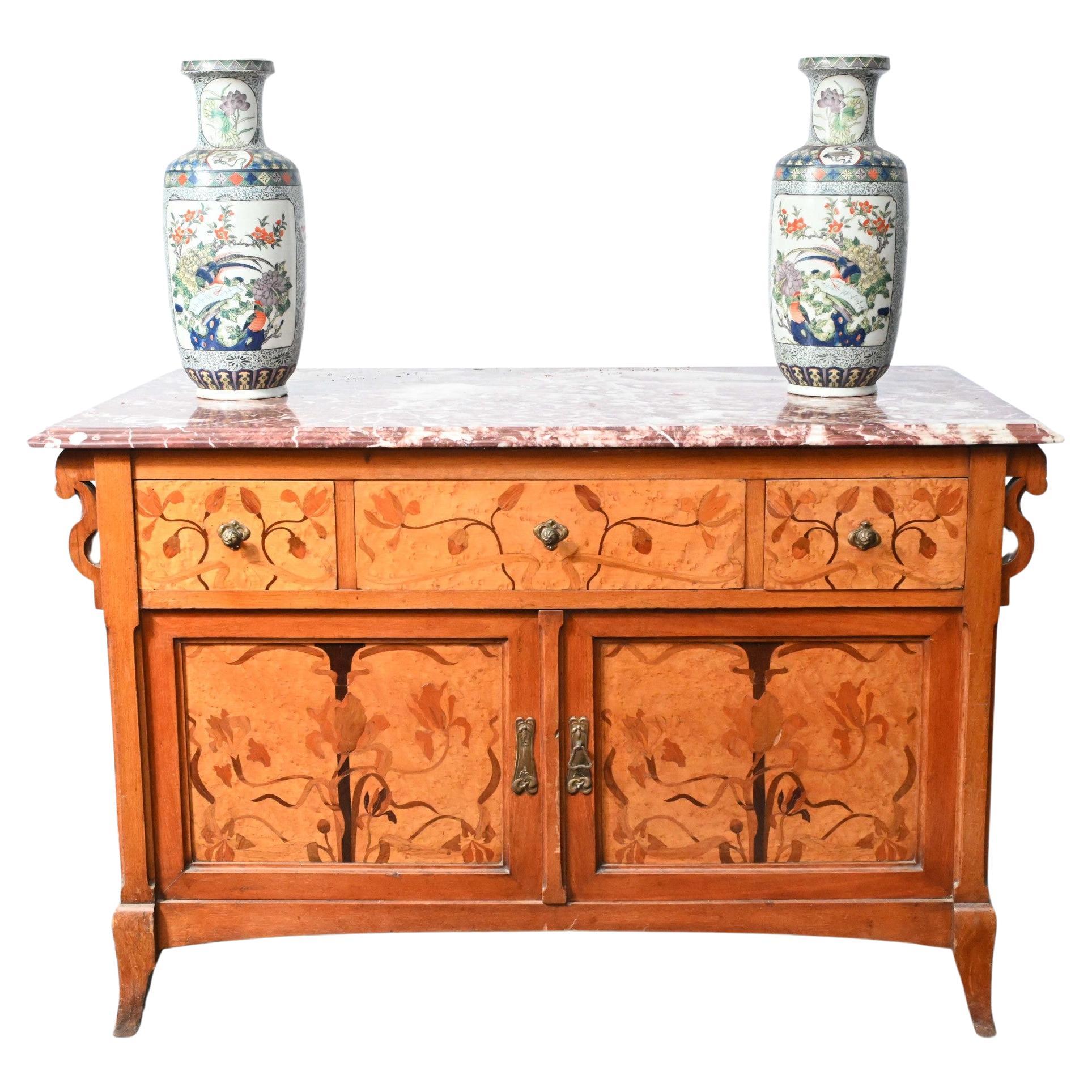Items Similar to Emile Gallé "Aux Ombelles" French Art Nouveau Cabinet
Want more images or videos?
Request additional images or videos from the seller
1 of 6
Emile Gallé "Aux Ombelles" French Art Nouveau Cabinet
About the Item
A French carved and fruitwood marquetry inlaid Ombelliféres vitrine by Emile Gallé. The vitrine has marquetry ombelle flowers in its interior and on the panel below the bottom shelf. The interior has two small carved half shelves. The top and bottom have elaborately carved ombelle decorations. It sits on four sinuously carved feet, circa 1900.
The vitrine's front marquetry panel features three Berce des prés composed in a similar manner to Kitao Shigemasa's Tree peony and Finch. Through Takashima Hokkai, Gallé was able to borrow a copy of Fleurs, oiseaux par Shigemasa (Kachōe shashin zue). Like Shigemasa, Gallé worked in the aesthetic of kacho-e (birds and flower painting) with a thorough understanding of the grammar of ikebana (flower arrangement). Gallé's expertise was so great that he was entrusted with organizing an ikebana retrospective for the 1900 Exposition Universelle. Ikebana is composed of three elements: shin (heaven, sun, male), soe (earth, female), and hikae/tai (humanity, child.) Gallé has arranged his flowers according to the Moribana school, a style of ikebana that came at the apex of the Meiji restoration. Shigemasa had his peonies according to Moribana principles: the right most "soe" flower leans at 45°, the middle "shin" flower at 10° and the leftmost "hikae" flower at 75°. Pivotal to ikebana is the principles of harmony and balance. It is the function of the 45° soe flower through angle to balance out the 75° hikae flower. While Gallé did not follow the rigid rules of Moribana, this should not be seen as an indication of inferiority. Rather, Gallé has merely solved the problem of balance in a different manner. While Shigemasa created a sense of balance through angle, Gallé made rendered the leftmost flower in madagascar ebony . The dark value serves as a visual weight, balancing an arrangement that otherwise approaches imbalance. Next to the Berce des prés is an Écaille martre (Tiger moth). Native to the same prairies as the Berce des prés, the inclusion of the Écaille martre gives the vitrine the crepuscular setting that Gallé loved so much.
A similar cabinet is pictured in: Gallé Furniture, by Alastair Duncan and Georges de Bartha, Woodbridge, Suffolk: Antique Collectors’ Club, 2012, p. 307, plate 42.
Signed, ''Gallé'' in marquetry.
- Creator:Emile Gallé (Maker)
- Dimensions:Height: 58.25 in (147.96 cm)Width: 25 in (63.5 cm)Depth: 18 in (45.72 cm)
- Style:Art Nouveau (Of the Period)
- Materials and Techniques:
- Place of Origin:
- Period:1900-1909
- Date of Manufacture:circa 1900
- Condition:
- Seller Location:New York, NY
- Reference Number:
About the Seller
4.8
Recognized Seller
These prestigious sellers are industry leaders and represent the highest echelon for item quality and design.
Established in 1971
1stDibs seller since 2010
44 sales on 1stDibs
Typical response time: <1 hour
- ShippingRetrieving quote...Ships From: New York, NY
- Return PolicyA return for this item may be initiated within 3 days of delivery.
More From This SellerView All
- Émile Gallé "Grenouilles" Fruitwood CabinetBy Emile GalléLocated in New York, NYThis French Art Nouveau "Grenouilles" carved fruitwood cabinet by Émile Gallé features detailed and masterful marquetry depicting dragonflies and mushrooms in a lush, leafy landscape...Category
Antique Early 1900s French Art Nouveau Cabinets
MaterialsBeech, Fruitwood
- French Art Nouveau Wooden Pedestal by Emile GalléBy Emile GalléLocated in New York, NYA French Art Nouveau two-tiered square pedestal with carved and marquetry decoration by Emile Gallé. The pedestal has two marquetry shelves depicting leaves. Its four sinuous legs ar...Category
Antique Early 1900s French Art Nouveau Pedestals
MaterialsWood
- Art Nouveau Commode by Émile GalléBy Emile GalléLocated in New York, NYA French Art Nouveau marquetry commode by Émile Gallé. With original key. Circa 1890. The syncretic influence of Japanese art is keenly felt in Gallé's commode. The beginning of Galle's fascination with Japanese art can be traced back to his friendship with Hokkai Takashima (1850-1931), a fellow botanist and member of the École de Nancy. Their botanical dialogue was facilitated by the Shokobutsu mei-i, a book of Japanese names for botanical species. It is from Hokkai that Gallé gained a spiritual and symbolic understanding of nature. Along with other École de Nancy artists, Hokkai and Gallé exhibited together in the display window of René Wiener's papeterie. The store served as the office of Wiener's arts journal, the Nancy artiste, which regularly featured on its covers contemporary examples of Gansai (Japanese watercolor), Byōbu (folding screens) from the Rinpa school, Sumi-e (ink painting), and Ukiyo-e (woodblock prints). As a show of gratitude, Hokkai bequeathed a vast art book collection to Wiener. It is from this record that we know with certainty of which Japanese artists Gallé had knowledge. One of the books in Hokkai's collection was Hokusai's Les cent paysages du Fuji (Fugaku hyakkei.) This 1835 expansion of Hokusai's 36 views of Mount Fuji...Category
Antique 1890s French Art Nouveau Commodes and Chests of Drawers
MaterialsWood
- French Art Nouveau Wooden Pedestal by Emile GalléLocated in New York, NYA French Art Nouveau selette by Émile Gallé. Gallé made very few selettes of this quality and design during his career, and even fewer of those with curved lower pieces that reunite ...Category
Antique Early 1900s French Art Nouveau Pedestals
MaterialsWood
- Emile Gallé French Art Nouveau Games TableBy Emile GalléLocated in New York, NYA French Art Nouveau games table by Emile Galle´, featuring inlaid fruitwood marquetry depicting thistles and card suit symbols. The table's apron has a series of carved card suit sy...Category
Antique 19th Century French Game Tables
MaterialsFruitwood
- Émile Gallé “Bats and Iris” Table LampBy Emile GalléLocated in New York, NYThis exquisite Galle bat lamp is crafted from three-color cameo glass, featuring a delicate lavender-hued shade adorned with a golden finial, held aloft by th...Category
Early 20th Century French Art Nouveau Table Lamps
MaterialsBronze
You May Also Like
- Emile Gallé Style “Les Ombelifères” Cabinet, 1960sBy Emile GalléLocated in Rijssen, NLAn exceptional and complex mixed wood cabinet with carved walnut and exotic wood inlays. Everything is there: the love of plants and nature with sculpted elements and the inlaid deco...Category
Vintage 1960s French Art Nouveau Cabinets
MaterialsWood
- French Art Nouveau Walnut Display CabinetLocated in London, GBA French Art Nouveau walnut display cabinet, with foliate carving, an arch top, two bevelled glazed doors, eight drawers with Art Nouveau gilt brass handles, on foliate scroll feet. ...Category
Early 20th Century Art Nouveau Cabinets
MaterialsWalnut
- Gallé Art Nouveau vitrineBy Emile GalléLocated in Saverne, Grand EstShowcase signed "Gallé" in walnut and veneer, decorated with clematis. It opens on the front with a large glazed leaf and a small leaf in the lower part. The locks and the lighting s...Category
Early 20th Century French Art Nouveau Vitrines
MaterialsWalnut
- Art Nouveau Commode French Cabinet Floral InlayLocated in Potters Bar, GBGorgeous art nouveau commode or cabinet in blonde walnut Features intricate inlay work showing floral motifs and designs Comes with the coloured marble top which is smooth and chip free Great purchase on Rue de Rossiers at Paris antiques markets...Category
Vintage 1980s Art Nouveau Cabinets
MaterialsWalnut
- Art Nouveau Burlwood CabinetLocated in Tulsa, OK**Please Read Entire Description** Please view all listing pictures on a laptop if possible. Some cell phones don’t display all listing pictures and some could be pictures relatin...Category
Vintage 1940s Italian Art Nouveau Cabinets
MaterialsOak, Maple, Burl
- Late 19th French Art Nouveau Walnut CabinetLocated in Miami, FLThe Vertiko made from walnut with brass fittings, a mirror with facet cut, with typical Art Nouveau ornamentations. In good restored condition with the original glasses and mirror.Category
Antique Late 19th Century French Art Nouveau Cabinets
MaterialsMirror, Walnut
Recently Viewed
View AllMore Ways To Browse
French Kitchen Art
Art Nouveau Kitchen
Weight Balance
Galle Art Nouveau
Elaborate Antique Cabinet
Exposition 1900
Galle Signed
Antique Cabinet Plates
Flower Carved Cabinet
Used School Storage Cabinets
Antique Painting Cabinets
Antique Galle
Art Nouveau Setting
Nouveau Panel
Art Nouveau Panels
Galle Style
Galle Emile
Emile Galle
